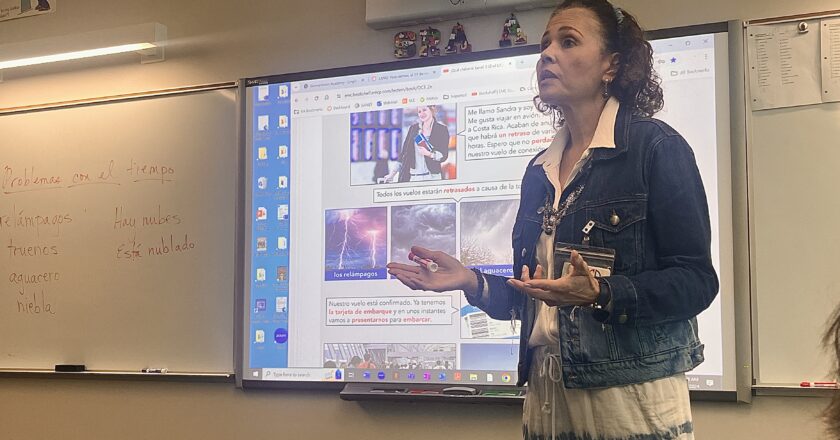GA’s classrooms are filled with students from various cultural backgrounds, boasting a student body comprising around 30% of people of color. Even 56 years ago, when the first student of color graduated, the thought of having a diverse student body, let alone a diverse faculty, seemed unattainable. The school has undoubtedly come a long way in Diversity, Equity, Inclusion, Justice, and Belonging (DEIBJ) throughout its 265-year history.
However, despite a diverse student population, the number of faculty members and administrators of color remains disproportionately low. Statistics from this year reveal a contrast of 30% of Upper School students of color compared to 15% of US faculty and 18% of school administration, two out of 11 of whom are directors of DEIBJ in the school.
A diverse faculty is extremely important. For example, it allows students of color to be inspired by and find mirrors in educators who share their experiences firsthand. Additionally, for the entire school community, they can introduce a wider range of insights, fostering a culture of inclusion through exposure to different groups. A diverse administration can likewise bring a myriad of perspectives to leadership decisions that impact students, and more easily address DEIBJ. The impacts of having diversity can even be reflected in the sentiments of faculty members.
“I didn’t see very many Asian Americans in school leadership as a classroom teacher.” Ms. Sarah Na, Associate Director of Equity and Inclusion and former Lower School teacher, said. “It wasn’t something that I imagined for myself.”
Many of these challenges, however, are not unique to GA and can be attributed to geographical limitations. Other institutions, especially in a region with limited diversity, can struggle with recruiting and retaining diverse educators.
While lacking statistically, GA has already put significant effort into improving diversity.
A Diversity and Community Life Coordinators team is highly involved and oversees the fulfillment of the GA Equity & Inclusion Action Plan 2.0, updated in 2020. This plan covers the areas of ‘Hiring and Retention’, ‘Community Education and Programming’, ‘Policies, Procedures and Protocols’, and ‘Alumni Engagement’.
In addition to diversity training, falling under the plan’s second category, in-school professional development panels called ‘Difference Matters’ have been implemented. Featuring presentations from students, faculty, and guests alike, the goal of these panels is to educate and address the unique experiences of the community. Faculty often attend these, demonstrating their commitment to taking steps toward building meaningful relationships with students.
One of GA’s Black Student Alliance (BSA) leaders, Anthony Hall ‘25, underscored the impact of other spaces that allow students to express their individual experiences. He specifically mentions the transformative experiences of poetry readings and posting on blogs. These platforms are available to people who wish to traverse through sliding glass doors, or empathetically learn about experiences different from their own.
“I’ve had teachers come up or staff or even students who are like ‘I really appreciate that’ or ‘I didn’t know that.’” Hall said. “So trying to educate and appreciate at the same time; I think that’s really how you reach the staff, faculty, and population of GA… If we’re honest and we present the issues, someone’s going to hear it.”
From a faculty perspective, Ms. Na believes her own story is a good model for what a more fleshed-out mentorship program to support a diverse faculty could look like.
“Ms. Szczepkowski, [the Head of Lower School] mentored me and… would share with me, ‘I see a lot of leadership qualities in you, and you should pursue this professional development’ which empowered me to lead initiatives around diversity that I was passionate about,” Ms. Na said. “She created spaces for me to hone leadership skills as a Diversity Community Life Coordinator.”
Although numerous efforts have been made towards DEIBJ for students and faculty, most of the student body stays uninformed about these initiatives.
“[The leadership team] have spent a lot of time talking about that really critical word ‘operationalized’,” Dr. Molly MacKean, Upper School Head, said. “At the end of the day… students need to feel that it’s real to us. That’s our challenge as adults: how are we showing that we’re growing in ways that students can feel in their day-to-day lived experiences and how are we, as adults, measuring our progress towards the commitments that we have put on paper?”
GA’s educators and leadership are dedicated to operationalizing diversity, making it a reality in the classrooms and halls students walk through each day. This is a commitment that requires continuous reflection, growth, and action from everyone.
“When we recognize that those changes are going to take time, take your investment, and take hard questions asked of ourselves and our practices,” Dr. MacKean said. “I am proud of the steps that we are taking at this moment, and I’m fully aware that there is a long way to go.”
By looking back on how far the school has come and continuing to prioritize a commitment to progress in DEIBJ areas, GA can build a school community that reflects the rich diversity of the student body.
Sources:
- GA’s Equity and Inclusion Commitment
- GA Quick Facts
- GA’s Archive Room & Yearbooks
- “Mirrors, Windows, Sliding Glass Doors”

